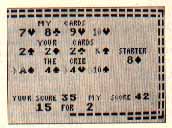GAME OF THE MONTH
Cribbage Atari
Play the game without worrying about lost pegs. By David Osborn

Now you can play the classic card game cribbage without needing to worry about finding the cribbage board--or remembering just how the scoring goes. Cribbage Atari is a fast BASIC program that works on any Atari 8-bit computer with at least 48K memory, disk or cassette.
Cribbage Atari is a fast, clear version of the popular card game. Pitting one player against the computer, it's also an easy way for beginning players to learn the scoring and strategy of cribbage, before getting out the pegboard and challenging human opponents.
Written entirely in BASIC, the graphics are kept simple enough that the play is at least as fast as the average human opponent. The cards are displayed by rank and suit, instead of with miniature pictures of cards.
All modesty aside, I believe most players will find Cribbage Atari a worthy opponent.
GETTING STARTED
Type in Listing 1, CRIBBAGE.BAS, check it with TYPO II and be sure to SAVE a copy before you RUN it. This is a long listing, but it's not at all tricky to type.
To play the game, just follow the onscreen instructions. The program first displays the title and starts setting up the character set. Setting up takes some time, so to keep you from getting too bored the program will inter rupt itself to ask you questions.
The first question lets you set the speed of play. Beginners and first timers should try a setting of [5], so they have time to follow the scoring.
Next the program asks whether you want to use a joystick or the arrow keys. Type a [K] to use the keyboard or a [J] to use the joystick.
If you use the joystick, move the selector arrow with the stick and press the button to signify your choices.
If you use the keyboard, use the arrow keys to move the cursor (you do not need to press [CONTROL].) Use the [INSERT] key to make your selections.
Once the play screen comes up, you're dealt six cards. The program displays the suits in black and red, with numbers and letters indicating rank. When adding card values together, each card is worth its face value. Aces count as one, all face cards count as ten.
THE CRIB
The first thing you must do is pick two cards for the crib. (You have to wait for the computer to take its turn first.) The cards you select are placed face down in the area marked either YOUR CRIB or MY CRIB. If you accidently choose the wrong first card, choose the space where that card was and your hand will be redisplayed so you may choose again. Once both cards are chosen--well, a card laid is a card played.
The cards in the crib become a second hand that either you or the computer plays for points. When it's YOUR CRIB, you discard the cards that will be most likely give you points, while keeping as many points as possible in your hand.
When the computer says it's MY CRIB, you try to get rid of useless cards that won't help the computer.
Once you have selected your crib cards, the STARTER card is revealed, and you're ready to play.
POINT SCORING
There are two ways to get points in cribbage. Certain combinations of cards in your hand are automatically worth points--pairs, runs, flushes, and combinations of 15 (an eight and a seven, a five and a ten, and so on.)
The starter card is counted as a part of your hand. If you have the jack of the same suit as the starter card, you also get one point for "nobs."
The other way to get points is through game play. The player who doesn't get the crib plays first. If the computer plays a 10, and you follow with a five, you get two points for making a total of 15. If the computer then plays a five, it gets two points for a pair. Runs of three or more consecutive cards (a two, three and four, for example) also count. A total of 31 gets two points.
If one player can't play in turn without putting the total over 31, the other player gets to "go" until also unable to play. One point is awarded for the last card played, and the total returns to zero.
As soon as all the cards have been played, it's time to count up all the points in each hand.
If all this sounds confusing, don't worry--the computer does all the scoring for you, telling you each time what the points are for. Arrows point to the cards involved, and a message flashes at the bottom of the screen, such as "PAIR FOR 2" or "15 FOR 2". It's an excellent way for beginners to learn the scoring system. (Experienced players will probably want to speed up the game at the first screen, since they don't have to worry about following the scoring.)
When playing with cards, cribbage scores are kept on pegboards. The computer simulates this by showing rows of pegs onscreen, one peg for each point. The screen's perimeter allows only 60 peg spaces, so the computer will lap the perimeter twice, for one game of 121 points.
David Osborn of Bismarck, North Dakota has a B.S. in Mathematics and enjoys games of all kinds, especially strategy. This is his first appearance in Antic.
Listing CRIBBAGE.BAS Download